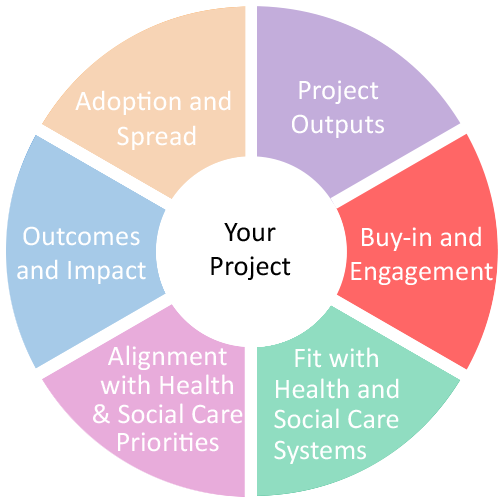Buy-in and Engagement
This domain helps you consider who needs to be engaged as part of the implementation process, what routes to engagement to use and how engagement will be maintained during implementation.

What should I consider for my project?
Implementation has been shown to have a greater chance of success with the right buy-in and engagement which will overcome challenges to adoption, promote coherence and confidence, facilitate organisational change and overcome barriers such as individual resistance.
- What are the potential challenges to implementation?
- How will you promote your project to increase confidence and coherence?
- Who do you need to engage to facilitate organisational change?
- Who will help overcome resistance to implementation?
Take time at the beginning to consider the different organisational contexts where implementation will take place. Undertake a stakeholder analysis to identify and map a range of stakeholders, both internal and external. You should assess the nature of their input and influence. It is important to consider specific roles rather than named individuals, particularly, if they are not part of your existing network. This will help ensure you understand the challenges and opportunities in each organisational context and have the right people and skills on board to promote and support implementation. Consider who will be impacted by implementation. For example, clinicians who operationalise your intervention may experience changes to their current professional practice or routines. Consider who has responsibility for resources required and who has strategic influence to decide if the project output is adopted and ensure they are engaged as part of the implementation process.
- Which individuals/organisations need to be engaged?
- What are the required strengths and assets that they can bring to the project?
- Who will be impacted by implementation?
- Are there key proponents or champions who can make the case for implementation and manage any resistance or attempts to derail implementation?
- Is there patient and public engagement to ensure that those who use services can be heard and listened to?
From the beginning - it is never too early to seek buy-in and engagement! It is essential at the design and development phase or ideally when developing initial ideas. This is a key time to carry out stakeholder mapping and aim to think inclusively as possible. Share with key people in partner organisations and ask them if they think anyone is missing.
- Who do you need to involve from the beginning?
- How will you identify who else you need?
Be inventive and consider the most appropriate way to engage with each setting. Be flexible and ready to adapt to suit their needs and timescales. Remember that you will need to be persistent. Engagement is often an ongoing process that requires using different approaches and formats throughout the project. Direct or virtual approaches such as meetings to inform others about your innovation and ensure understanding with opportunities for questions are helpful. Utilise your existing networks and ask people to identify and approach others on your behalf. Invite potential participants to presentations/workshops and add them to mailing lists of key events to hear about your study. Ensure you have patient and public involvement as this will help momentum to be maintained and not constrained by organisational hierarchy or protocol. It can also highlight the importance to service users, so is key. Maintaining engagement is challenging and influenced by many internal and external factors. Help to ensure ongoing buy-in and engagement through communication, events and networks involving your collaborators. For example, local implementation champions are key and have clinical and systems knowledge and capacity to lay groundwork for adoption and ensure responsiveness. They provide local leadership, promoting the value and benefits of implementation.
- How can you directly engage with key people?
- What other routes and formats can you use?
- Who can help you engage with others?
- How will you ensure and support patient and public involvement?
- How will you maintain engagement?
- How will you ensure shared agreement about the work needed and who will carry this out?
Engagement may look different for various contexts and will be dependent on your type of project. It may involve co-production; to work collaboratively to design and develop the project output and/or including key partners as project co-applicants/collaborators or advisory board members.
- How will you know you have the right engagement?
- How will you sustain and expand engagement?
You will need to ensure high level endorsement from the appropriate people. Involvement of senior managers can be a catalyst to implementation and support communication, training and awareness. Buy-in at organisational level will be needed for changes to policy and organisational guidance; ensure you involve clinical governance managers. It is always useful to have evidence of an organisation’s buy-in and engagement, such as a letter of support, contract or co-working agreement.
- Has high-level endorsement been secured from the appropriate people?
- Have you got formal evidence of buy-in and engagement?
- Who can help ensure governance and policy procedures are met?
Case study
Drive Partnership Working Project (DPWP)
“From the start, we decided it was important to use our current networks and involve key people who had established credibility and who were trusted. The commitment and drive for the project by the lead ensured others readily identified its value and were prepared to engage and commit to see the project to realisation. We involved our Communications Team at this early stage and provided regular updates both internally and to partner organisations so that they were aware and felt involved in the project. We continued to recruit key people from partner organisations so that they would spread the message and obtain buy-in within their organisations. Our stakeholder group established a clear plan, including ensuring we considered all governance processes and decisions were actioned. We also identified early on who our ‘anti-champions’ were and discussed how we would manage their resistance or if they attempted to derail implementation. It was a massive team effort that required time and input from all involved. We also confirmed our organisation was fully committed to adoption and this enabled us to show that the intervention was commissioned. This resulted in other organisations having reassurance and confidence to engage and not having to ‘take a risk’ and be the first to sign up.”

Take away tips
- Buy-in and engagement is integral and should be considered at the start and throughout implementation
- Engagement is necessary at all levels and must be sustained